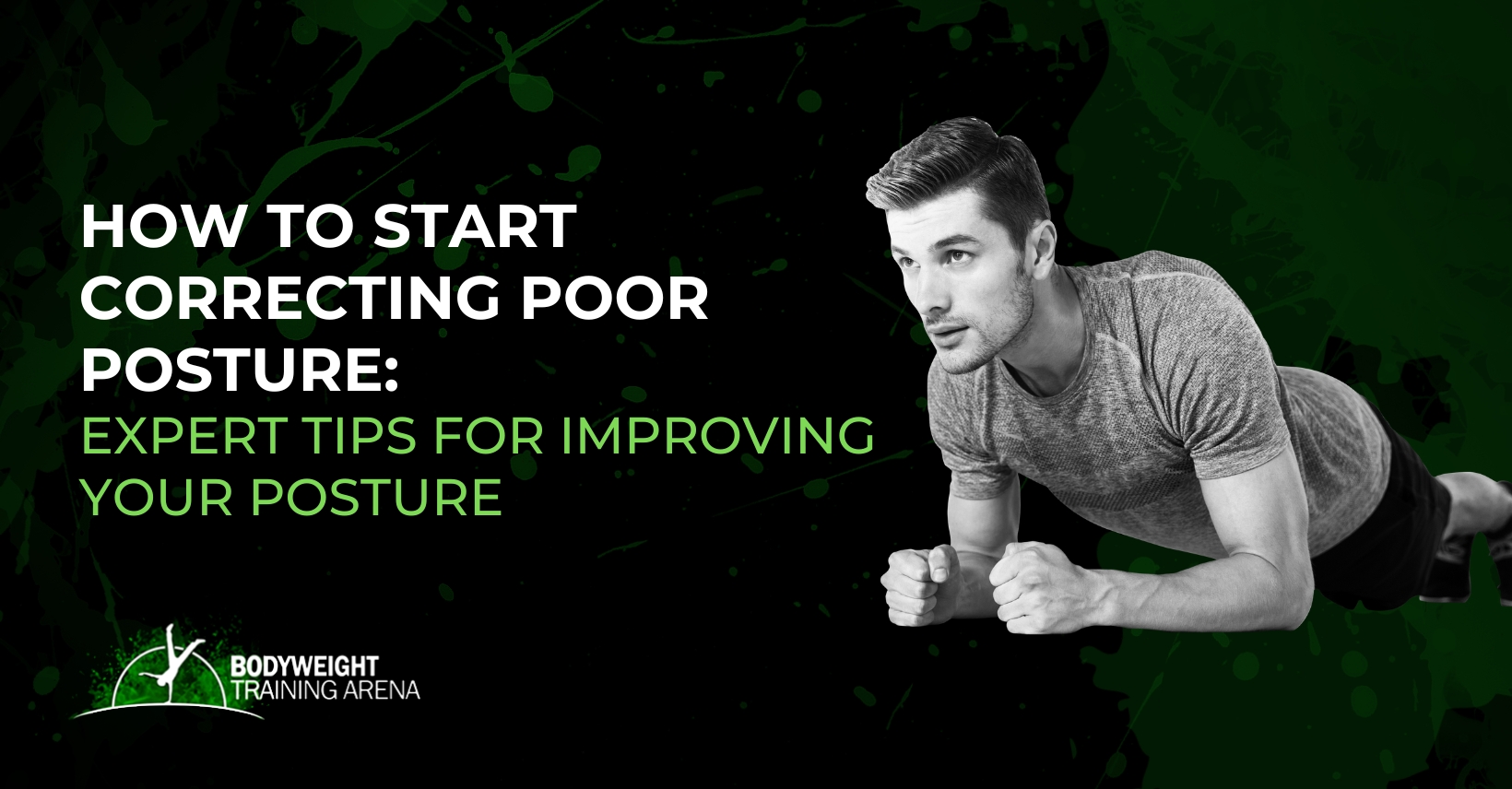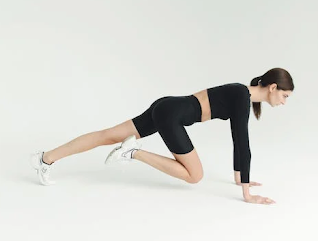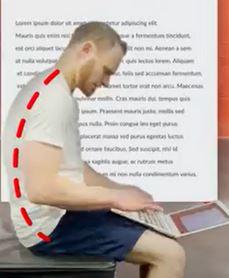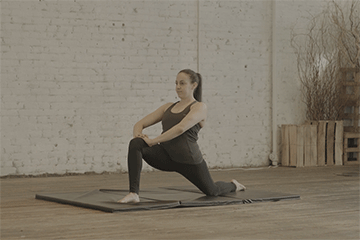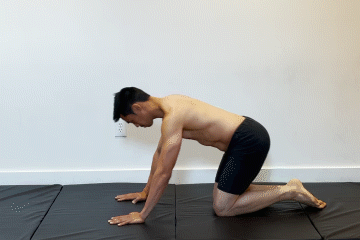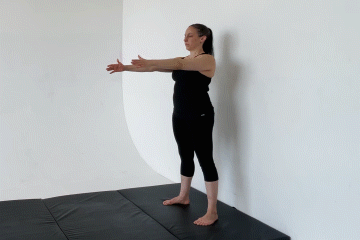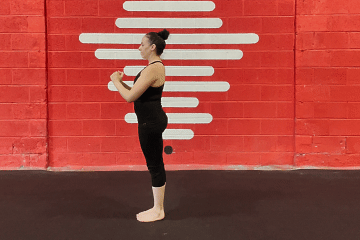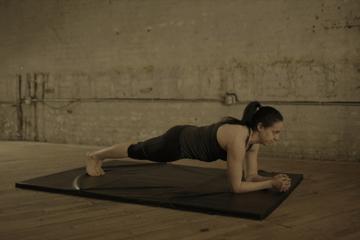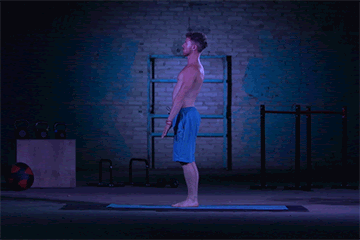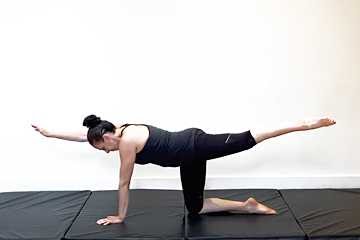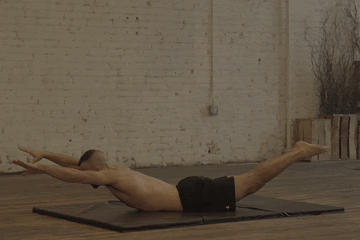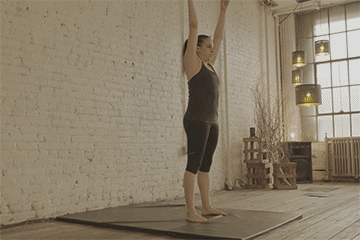Good posture is an essential part of maintaining physical and mental wellness. Unfortunately, many people struggle to maintain proper posture due to various factors like poor ergonomics or simply unnecessary strain on their bodies!
However, the good news is that you can take proactive steps toward correcting any issues you may be experiencing with your daily habits.
How to get started with correcting poor posture?🤔
Good posture is essential for good physical, mental, and emotional well-being.
Poor posture strains the body, puts pressure on the joints and muscles, increases fatigue levels, reduces flexibility, and affects mood–even leading to depression if left uncorrected.
So. how to get started with correcting poor posture?
Start correcting your posture by strengthening the muscles that support your body, such as the core, back, and shoulder muscles. Strengthening these areas makes it easier to maintain good posture for a more extended period. Additionally, you can practice exercises specifically designed to improve posture.
This blog post will cover important factors to consider when correcting your posture and practical exercises you can practice to help correct it.
⏬Table of Contents:
- What is good posture?
- What Causes Bad Posture?
- Effects of Bad Posture
- Benefits of good posture
- Improve Your Posture With Core Exercises
- How to Strengthen Back Muscles
- Shoulder Mobility
- Increase Flexibility
- Utilize Good Ergonomics
- Frequently Asked Questions
👍What is good posture?
Good posture is essential for proper spine alignment, which impacts the entire body. It helps to reduce strain on muscles, ligaments, and other tissues, improving overall health and well-being. Proper posture also helps with balance and coordination and can help to prevent falls.
When a person exhibits a good posture, their body should have a straight line from their ears to their shoulder, to their hips, and be in alignment with the ground. The shoulders are relaxed and pulled back slightly, the chin slightly tucked in, and the feet hip-width apart for stability.
🧐What Causes Bad Posture?
Bad posture can be caused by various factors, including poor ergonomics, muscle imbalances, unhealthy lifestyle habits, and even genetics.
👎Poor Ergonomics
Poor ergonomics refers to how people use their bodies and the environment around them. Poor ergonomics can be seen in people sitting at their desks, using a computer mouse, or holding their phones. It can lead to bad posture, making postural muscles weak or overused.
👎Muscle Imbalances
Muscle imbalances can also cause bad posture, as muscles that are overactive or too weak will not be able to support the body properly and can create postural issues. As a result, you may be slouching or developing an exaggerated curve in your spine.
👎Unhealthy Lifestyle Habits
Bad posture can be caused by prolonged sitting, smoking, carrying heavy bags, or not exercising regularly. This can lead to shortened and weakened postural muscles, making it difficult for people to maintain good posture.
👎Genetics
Genetics can play a role in bad posture as well. Some people are born with conditions that cause poor postures, such as scoliosis or joint issues.
🤕Effects of Bad Posture
Many negative effects of bad posture can impact physical and mental health.
Here is the list of the most common effects of bad posture:
❌Excess strain on the muscles, joints, and ligaments
Poor posture can lead to excess strain on the muscles, joints, and ligaments. This can cause pain in areas such as your back, neck, and shoulders, debilitating and interfering with daily activities. Poor posture also places excessive stress on the spine, which can throw off its alignment and cause long-term damage.
❌Increased fatigue levels
Poor posture can lead to increased fatigue levels. This can make it difficult for people to focus, remember complex tasks, or stay motivated throughout the day.
❌Decreased flexibility
Poor posture can lead to decreased flexibility in some regions of the body, such as the spine and shoulders, which can further contribute to pain and discomfort. This can further impede performance in daily activities and make it difficult to move your body.
❌Affects mood
Poor posture can also affect mood, leading to depression and low self-esteem. This is because poor posture often leads people to slouch or hunch over, which can cause shame or insecurity. It can also lead to helplessness since poor posture is often seen as something that cannot be changed.
❌Poor circulation
Poor posture can also lead to poor circulation, which can compress the veins and arteries, making blood flow difficult. This can cause fatigue, dizziness, and a decreased ability to concentrate.
❌Headaches and neck pain
Poor posture can also lead to headaches and neck pain, which can cause further fatigue and distress. Concentrating or staying focused can also be difficult due to the pain and discomfort.
❌Loss of confidence due to slouching or hunching over for extended periods of time.
Poor posture dramatically affects one’s self-confidence, making one appear less attractive or professional. In addition, slouching or hunching over for extended periods can make people feel ashamed and insecure about their appearance, leading to low self-esteem.
❌Compromised breathing which can lead to shallow breathing patterns.
Poor posture can also lead to restricted breathing, as the chest and diaphragm can compress. This can lead to shallow breathing patterns, further impair physical performance and reduce overall energy levels.
Fortunately, these problems can be corrected by strengthening the postural muscles and improving flexibility which can be attained through regular workouts. Additionally, sitting and standing in the correct posture for extended periods is important.
🏆Benefits of Good Posture
Good posture is essential for proper health and well-being. It can help improve physical and mental health while boosting confidence and increasing flexibility. Regularly practicing correct posture techniques will help you maintain healthy postural habits to reap all the benefits.
Here are some of the many benefits of maintaining good posture:
👏Improved physical health
Good posture helps to keep the spine healthy and aligned, reducing strain on the muscles, joints, and ligaments. This can help reduce pain in areas such as your back, neck, and shoulders while preventing long-term damage.‘
👏Enhanced mental clarity
Good posture helps to improve circulation throughout the body, which can increase oxygen levels in the brain. This can improve focus and concentration levels, making complex tasks easier to remember or staying motivated throughout the day.
👏Increased flexibility
Good posture helps maintain proper alignment of your body’s joints, allowing for increased mobility and range of motion when moving around or performing activities like exercise or sports.
👏Boosted confidence
Standing tall with good posture gives people a sense of pride in their appearance, which makes them feel more confident about themselves overall. This is because good posture often makes one look taller and more professional than slouching or hunching over would do otherwise.
👏Better breathing patterns
Proper alignment of the chest cavity encourages deeper breaths, allowing for better oxygen intake into our bodies, and boosting our mood instantly, according to a study.
🎯Improve Your Posture With Core Exercises
Core exercises are an important component of posture correction. Core exercises involve strengthening the abdominal muscles and spine, which helps to maintain an upright posture. Core exercises are often done using body weight, such as planks or bridges, but can also be done with weights and resistance bands.
✨Core Exercises for Improving Posture
Core exercises are a great way to improve posture and reduce pain associated with poor posture. Below are five core exercises that can help strengthen the muscles surrounding the spine, abdominal muscles, and hips to maintain an upright position:
💯Hip Openers Exercises
Hip openers are a great way to increase flexibility in the lower body and back and create space for better circulation and energy flow. Among the most critical joints in the body, the hips play a crucial role in posture, balance, and overall stability. You can reduce hip pain or tension by practicing hip openers regularly.
Here are some hip openers you can try:
👊Pigeon Pose
Start on all fours, then bring one leg forward so the shin is perpendicular to your body. Allow the thigh of the other leg to rest on the ground. Hold for up to five minutes on each side.
👊Low Lunge
From standing, step one foot back and lower into a lunge, keeping the front knee bent at a 90-degree angle. Push through your back heel and hold for up to five minutes on each side.
👊Lizard Pose
From a low lunge, lower both forearms onto the ground inside of your forward leg. Hold for up to one minute on each side.
👊Butterfly Pose
Sit up straight on the ground. Bring the soles of your feet together and allow your knees to fall open like butterfly wings. Place a block or bolster underneath each knee for support as needed.
Hold for up to five minutes.
👊Glute Bridges
Lie on your back with your feet planted firmly on the ground and knees bent. Push through your heels to lift your hips up as high as you can before slowly lowering them back down. Do three sets of eight repetitions.
🎯Hip flexor Exercises
Hip flexor exercises help strengthen the muscles around your hips and pelvis. Strengthening these muscles helps improve hip mobility, flexibility, balance, and posture.
There are a variety of exercises that target the hip flexors. These include:
✔️Lunge
Stand with your feet about shoulder-width apart, tep right foot out, back straight and lean forward into the deep lunge.
⭐️Standing Quadriceps Stretch
This stretch is excellent for loosening the hip flexors and strengthening the quadriceps. To perform this move, stand in a staggered stance with one foot slightly ahead of the other. Place your hands on your hips and bend your front knee until you feel a gentle tension in the back of your thigh. Hold this position for 30 seconds, then switch feet and repeat.
🤜Fire Hydrant
This exercise is excellent for activating the hip flexors and glutes in a controlled manner. Start on all fours with your hands directly beneath your shoulders to perform this move. Then, keeping your right knee bent, lift it to the side as if you are going to “mark your territory” like a dog. Hold for five seconds, then lower the leg back to the ground and repeat on the other side.
🤜Sit Back Training (against wall)
This exercise is excellent for simultaneously building strength in your hip flexors and quads. To perform this move, stand with your back against a wall and slide down until your thighs are parallel to the ground. Hold this position for 30 seconds, then relax and repeat. The wall sit is another excellent exercise for strengthening the core and improving posture. To perform the wall sit, stand with your back against a wall and slide down into a squat position. Ensure your knees are bent at 90 degrees and your feet are flat on the floor. Hold this position for 30 seconds before returning to standing.
🤜Reverse Lunge
This exercise helps strengthen and stretch the hip flexors simultaneously. To perform this move, stand with your feet shoulder-width apart. Then, step backward with one foot and lower your hips until both knees are bent at 90-degree angles. Keep your front knee over your ankle, then push through the heel of your back foot to return to a standing position. Repeat on the other side.
🤜Plank
This exercise is excellent for strengthening the entire core, including the hip flexors. To perform this move, start in a pushup position with your arms straight and directly beneath your shoulders. Next, lower your body until your forearms are on the floor, then hold for 30 seconds. Relax, then repeat. The plank is a great core exercise that helps to strengthen the abdominal muscles and spine. To perform the plank, start in a pushup position with your hands directly below your shoulders. Next, engage your abs and glutes to lift your hips slightly. Hold this position for 30 seconds before returning to the starting position.
These simple exercises can help you strengthen and stretch the hip flexors to maximize mobility and flexibility. Always warm up before performing these exercises, and listen to your body for any signs of discomfort. With consistency, you’ll soon be able to move through a full range of motion quickly.
💥Other exercises
Below are other exercises that can help improve posture, balance, and flexibility.
✅Knee Tucks
This exercise is excellent for strengthening your core without putting too much strain on your back. To perform this move, start in a tabletop position with your hands directly beneath your shoulders and knees below your hips. Next, engage your abs and glutes as you use your upper body to pull your knees into your chest. Then, extend them back out while keeping the tension in your core muscles.
✅Single Leg Bridge
This move helps to strengthen the glutes, hamstrings, and hip flexors while also engaging the core. To perform this move, lie on your back with one knee bent and the other foot flat on the floor. Keep your abs tight as you press through your heel to lift your hips off the ground. Hold for five seconds, then lower back down. Repeat on the other side.
Read more on bridge exercises with this article: Bridge Progression
✅Single Leg Deadlift
This exercise strengthens the glutes, hamstrings, and core. To perform this move, stand on one foot with your feet shoulder-width apart and reach the opposite leg out behind you. Lean forward while keeping your back flat and extend your arms out in front of you. Return to a standing position by pressing through the heel of the standing leg. Repeat on the other side.
✅Bird Dog
The bird dog is an exercise that helps to strengthen the muscles of the lower back and spine while also engaging the arms and legs. To perform the bird dog, start on all fours with your hands beneath your shoulders and your knees beneath your hips. Next, engage your core and extend one arm in front of you while simultaneously extending the opposite leg behind you. Hold this position for 30 seconds before returning to the starting position.
Interested in strengthening the muscles in your lower back? The following articles deal with the lower back:
⚡️How to Strengthen Back Muscles?
Strong back muscles are essential for good posture. Conversely, when the back is weak, it pulls the spine out of alignment and can lead to poor posture habits over time.
Begin strengthening your back muscles with exercises with the following movements:
Related article: Build Strong Back At Home: 9 Calisthenics Back Exercises No Equipment
✊Bent-Over Rows
Bent-over rows are a great exercise to target the middle and upper back muscles. To perform this exercise, start with your feet hip-width apart and bend over at your hips so that your chest is parallel to the ground. Keep your core tight as you bring one arm up to the side of your chest and slowly lower back down. Make sure to keep your elbow close to the body throughout this movement.
✊Reverse Flyes
Reverse flies help to strengthen the upper back muscles while improving stability and posture. Start with a light set of dumbbells to perform this exercise, and stand with your feet hip-width apart. Next, bend your knees slightly and hinge at the hips, so your chest is parallel to the ground. Then, keeping your arms straight, lift both dumbbells out to the sides of your body and slowly lower back down.
✊Superman
The superman exercise is a great way to target muscles in the lower back. To perform this move, lie on your stomach with your arms and legs extended. Then, activate the lower back muscles by lifting your chest and legs off the ground while keeping your head in line with your spine. Hold this position for five seconds before slowly releasing it to the floor.
✊Prone Plank
The prone plank is a great way to target the muscles in the lower back while improving core and shoulder strength. To perform this exercise, start by lying on your stomach with your arms at your sides. Next, squeeze your glutes as you lift onto your elbows and toes. Keep your neck in line with your spine throughout this movement and hold for 30 seconds.
These four exercises are a great way to strengthen the back muscles and improve posture. Practice proper form and technique when performing each exercise to ensure you get the most out of your workout. With regular practice, you’ll soon find that your body is strong and stable with improved posture overall.
🔥Shoulder Mobility
Shoulder mobility is an essential part of any fitness routine. However, when the shoulder muscles are weak or tight, it can lead to poor posture and an increased risk of injury. To improve shoulder mobility, practice these five exercises regularly:
Related article:
- Best exercises for bulletproof rotator cuffs – Better shoulder performance and reduced risk of injury
- 5 Most Effective Exercises to Stretch Your Shoulders
- 6 Simple Tips to Avoid Shoulder Injury
☑️Arm Circles
Start by standing with your feet hip-width apart and arms extended out to the sides. BeginTight shoulder muscles can cause the shoulders to round forward and pull the spine out of alignment. To combat this, focus on stretching and increasing the range of motion in your shoulders. You can do this with shoulder rolls, arm circles, and wall slides.
☑️Shoulder Rolls
To perform this exercise, stand with your feet hip-width apart, roll your shoulders up to your ears, and then back down in a circular motion. Make sure to keep the chest open throughout this exercise.
☑️Wall Slides
This exercise helps improve shoulder range of motion and flexibility. To perform this move, stand facing a wall with your feet hip-width apart and place both hands on the wall at shoulder level. Then, keeping your arms straight and chest open, slide the hands up the wall as high as possible before slowly lowering back down.
☑️Lateral Raises
This exercise is excellent for targeting the muscles in the middle of your back and shoulders. To perform this move, stand with your feet hip-width apart and hold a light set of dumbbells at your sides. Keep the arms straight as you lift the weights to shoulder level before slowly lowering them back down.
☑️Chest Stretch
Stand with your feet hip-width apart to perform this stretch and place both hands behind your head. Gently press the elbows back until you feel a stretch in the chest. Hold this position for 20-30 seconds before releasing back to starting position.
These five exercises are great for increasing shoulder mobility and improving posture. With regular practice, you’ll soon find that your shoulders are stronger and more flexible than ever!
🔥Increase Flexibility
Flexible muscles are essential for good posture. However, it can be challenging to maintain proper alignment when your muscles are tight and inflexible. To increase flexibility, focus on dynamic stretching (stretching while moving) and static stretching (holding a stretch for an extended period). Here are five exercises that can help improve flexibility:
☑️Cat-Camel
This dynamic stretch helps to warm up the spine and loosen the lower back muscles. To perform this exercise, start on all fours with your hands directly under your shoulders and knees directly under your hips. Next, slowly round your spine towards the ceiling as you exhale, and then arch your spine towards the floor as you inhale. Alternate between these two movements for 8-10 repetitions.
☑️Cobra Stretch
This exercise improves upper back, shoulders, and chest flexibility. To perform this move, start on your stomach with your hands directly beneath your shoulders and your toes curled under. As you inhale, press the hands into the ground and lift the chest off the floor until you feel a stretch in your upper back and shoulders. Hold for 5-10 seconds before slowly releasing back to starting position.
☑️Downward Dog
This pose is excellent for lengthening the spine and loosening the hips. To perform this pose, start in a high plank position with your hands directly beneath the shoulders and feet hip-width apart. As you exhale, press into the hands and lift the hips towards the ceiling until your body forms an “A” shape. Hold for 5-10 breaths before slowly releasing back to starting position.
☑️Seated Spinal Twist
This pose helps to loosen the back, hips, and shoulders muscles while improving posture. To perform this stretch, sit on the floor with your feet together and knees bent. Cross your right leg over your left as you inhale before twisting your torso towards the right and placing your left elbow outside your right knee. Hold 5-10 breaths before returning to starting position and repeating on the other side.
☑️Chest Opener
This exercise helps open the chest and shoulders while improving posture. To perform this move, kneel on a mat with your feet hip-width apart and arms outstretched in front of you. Press your palms into the mat as you inhale, then arch your spine and reach your arms towards the ceiling as you exhale. Hold for 5-10 breaths before releasing back to starting position.
By practicing these five stretches regularly, you’ll soon find that your muscles are more flexible.
💯Utilize Good Ergonomics
Good ergonomics can help you maintain good posture. For example, invest in an ergonomic chair that supports your back and encourages proper posture. Ensure your computer monitor is at eye level, and use a keyboard tray to keep the wrists in a neutral position.
By following these tips, you can improve your posture and protect your health in the long run. So remember to stand tall and keep your spine aligned!
📌Takeaway
Good posture is essential for overall health and well-being. It helps us feel better, improves our daily performance, and reduces stress. Conversely, bad posture can lead to pain, fatigue, and mood changes.
Good posture is not just about looking good but feeling good, too. Regular practice and dedication can improve your posture and make a lifelong difference in your health.
To improve your posture, you should strengthen your core muscles, increase shoulder mobility, stretch your body, and use good ergonomics. Explore our app and find simple exercises to start your posture journey today.

